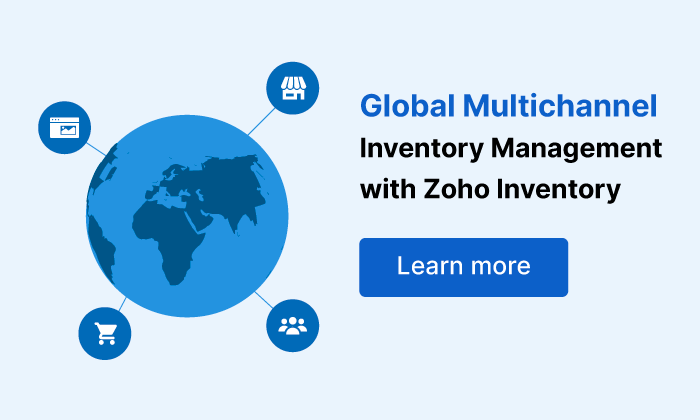Five tips for successful inventory management
Running a small business is not easy. Buying, selling, and administrative work all have to be taken care of on a daily basis, with limited resources. The most significant challenge for a small business entrepreneur is figuring out how to distribute their resources so that they can take care of important operations without overlooking other functions.
One of those important operations is inventory management. It’s a basic business function that can seem simple at first, but to achieve consistent sales and turnover, it requires a long-term strategy and a system for managing the daily work of warehouse staff. It also needs a way to eliminate errors like inconsistent or duplicate inventory data, which can cause a lot of harm to the business.
In this blog, we will be sharing the top five tips that you should follow to keep your inventory management on track.
Keep consistent SKUs
A Stock Keeping Unit, or SKU, is a unique name that you assign to an item so that you can identify and track it conveniently. Many new entrepreneurs don’t use a standard technique while assigning SKUs to their inventory items. When their item list starts growing, the jumbled-up item codes can lead to errors in their inventory records.
To avoid this confusion, you need to set a standard for your SKUs. To do that, just follow these 3 steps:
1. Identify the main attributes of the product
- Identify the main attributes of the product, like color, size, and shape. You may also want to include the manufacturer or supplier code, if the items in your warehouse are sourced from multiple locations.
2. Decide on a number of characters for each attribute.
- Decide on a number of characters for each attribute. Try to keep it the same for all of them, to make your SKUs more consistent and easy to remember.
3. Try an SKU generator
- Try an SKU generator, to cut down on boring work and mistakes (like using the same SKU for two different items). Here’s a free SKU generator tool that’s easy to use.
Categorize inventory into A, B, and C groups
An effective way to understand the inventory in your warehouse is to categorize the items based on their storage value (how much it costs to keep the item in the warehouse), and their sales frequency (how many units are sold in the market in a given amount of time). This allows a business to identify the most important and least important items from a cost and profitability point of view. To create your categories, you need to take a look at your stock list and consider each item’s storage value and sales frequency, then sort them into the following categories:
A: High storage value, low sales frequency
B: Moderate storage value, moderate sales frequency
C: Low storage value, high sales frequency
Logically, most of your warehouse space should be filled with category C items, but most of your storage cost will be spent on maintaining the category A items. Knowing which items are in which category helps you to plan your warehouse space allocation and train your staff on how to handle different items. It can also help you decide which items need extra protection during storage—for instance, category A items that will be in your warehouse for a long time may need extra ventilation to protect them from moisture, while items that sell quickly won’t be affected.
Use inventory forecasting
Inventory forecasting is a technique that helps you to be prepared and proactive in your inventory management. In this technique, you analyze past data such as your sales and demand to predict your future performance. With the help of inventory forecasting, you can avoid stock outs, retain your regular customers, and also stay ahead of your competitors.
You can get started with inventory forecasting without a specialized application. To start, observe your sales trends and try to calculate your average demand. Look closely at any spikes in the sales graph and try to remember the events that caused them. Are those events likely to happen again? This will help you to be more prepared for yearly cycles of demand.
Once you’re comfortable looking at your basic sales trends, try calculating your reorder point, safety stock, and economic order quantity. This will give you a more specific picture of when you should order items from your supplier, what quantity you should order, and what your buffer stock level should be. Learn more about inventory forecasting and how it can benefit your business in the long run.
Identify a technique for inventory valuation
Now, let’s move on to the end of the financial year. This is the time when you prepare your financial statements and evaluate the financial position of your business. As an owner of a small business, you’re probably well aware of the impact of your annual financial performance on the future of your business.
When we talk about financial performance, a lot of emphasis is put on the profit and revenue position of the company. Fair enough—for a growing company, those are the most essential elements to rely on. However, there are other important areas to pay attention to, like inventory valuation. Inventory valuation is a technique that is used to calculate the value of the company’s unsold stock at the end of the year. Unsold stock value is added into the balance sheet and also the profit and loss account, so it ultimately affects your profit.
But how do you find the value of the unsold items?
For that, there are three techniques followed in the accounting industry:
FIFO
First In First Out is a technique based on the assumption that items enter your warehouse in the same order they leave it. Under FIFO valuation, the items left unsold at the end of the year will be valued at the price of the batch of items that were purchased most recently.
LIFO
Last In First Out is a technique based on the assumption that the last items that entered your warehouse will be sold first. Under LIFO, the items left unsold at the end of the year will be valued at the price of the first batch of items purchased during the year.
WAC
Weighted Average Cost is a simple technique in which the unsold stock is valued at the average rate paid for the items throughout the year. The average is calculated by dividing the total cost paid for the items during the year by the total number of items purchased.
Understanding inventory valuation can be a tad difficult. Check out our detailed inventory valuation guide for more about how it works.
Invest in an order management system
The order management process includes a lot of individual processes: buying and selling goods from your warehouse or store, invoicing customers, managing bills from your vendors, packaging, and shipping. None of these activities work in isolation—they all are connected as part of one workflow.
Because the complete order management process involves multiple people and teams, it’s easy to make mistakes. But small inconsistencies in your inventory data can turn into bigger problems—for instance, attaching the wrong package number or shipping label to a box can send it to entirely the wrong location, creating two unhappy customers.
An order management system centralizes the whole operation and automates portions of it for a more accurate, efficient process. Manual data entry can be minimized with automatic import and smart suggestions, reducing your team’s workload. You can also streamline customer communication with automated shipping notifications, and improve collaboration within your team by bringing everyone’s work together on one platform. Ideally, your system will come with a mobile app so you can update orders and create invoices even while traveling.
If you’re worried about the cost of an order management system, then you can start with a free inventory management app and work your way up to investing in a long-term solution. We’ve put together some guidelines that will help you choose the best order management tool for your small business.
Every successful small business has a well-planned inventory management process running in the background. Reaching that level requires some small but important steps—even something as simple as the SKUs of your items can have a long-term impact on your business. A consistent naming pattern automatically sets you on your way to more reliable item management. ABC categorization helps you understand how your items are different from each other and how you can strategize your warehouse space to hold all of them. Inventory forecasting and valuation may seem like number crunching, but they are vital steps for the future of a small business.
When you’ve figured out these factors, you can make the call to invest in an inventory management system like Zoho Inventory. It is a cloud-based application that is easy to use and doesn’t require additional investment for setting it up. You can monitor the stock level, generate reports, track orders and items on intuitive dashboards. After you invest in an inventory system like Zoho Inventory, you’re off to a great start in setting up the inventory management process of your small business.
































